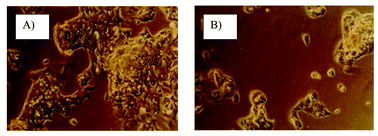Investigation of differentially expressed proteins due to the inhibitory effects of berberine in human liver cancer cell line HepG2
Abstract
The investigation of differentially expressed proteins was used together with other techniques to study the inhibitory effects of two different doses of berberine in human liver cancer cell line HepG2. For HepG2 cells treated with 24.0 mg l−1 of berberine, an increase in the sub G0 phase that was indicative of cell death was observed in cell cycle analysis with flow cytometry. However, no significant increase in sub G0 was observed in HepG2 cells treated with 4.0 mg l−1 of berberine. Using flow cytometric analysis, significant activation of caspase 3 was not observed with HepG2 cells treated with 4.0 and 24.0 mg l−1 of berberine. In this work, labeling of cells with stable isotope was not used in the proposed method developed. The whole cell lysates from the control and treated cells were digested with trypsin and the peptides were separated by two-dimensional (cation exchange and reversed phase) liquid chromatography and tandem mass spectrometry. Our preliminary data showed that the proposed platform provided a rapid approach to study the molecular mechanism due to the inhibitory effects of different doses of the berberine on HepG2 cell lines. This included a network of proteins involved in mitogen-activated protein kinase (MAPK) phosphorelay systems, metabolism, regulation of cell cycle and DNA damage response. The differentially expressed proteins identified using the current approach were consistent with the data obtained from cell cycle analysis with flow cytometry.


 Please wait while we load your content...
Please wait while we load your content...